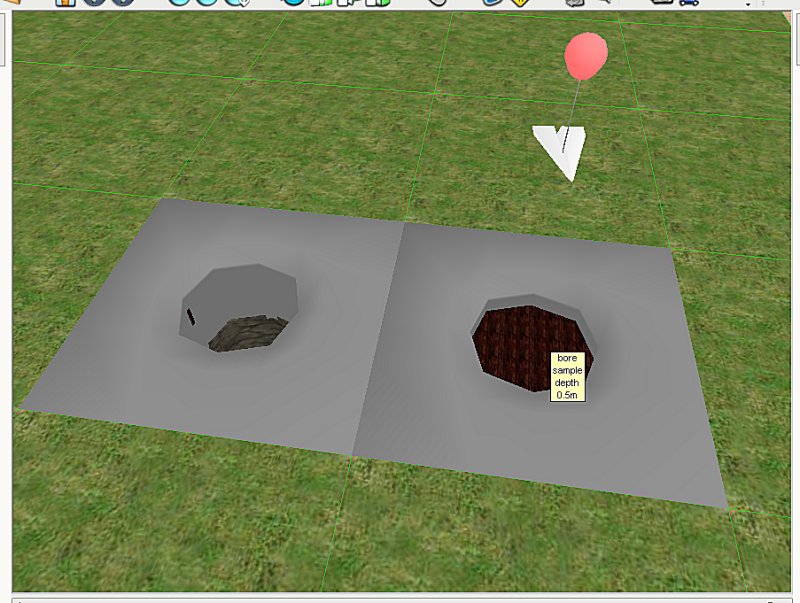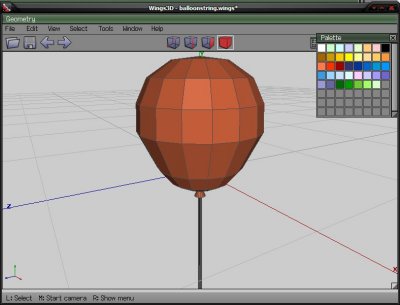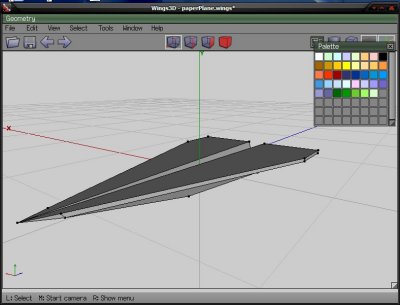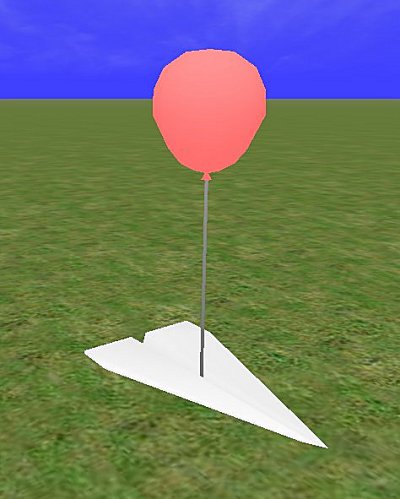It’s all in the Details
Given some skill, their own space and a little time it is wonderful to see year 9 boys so engrossed in an activity (to the point that none of us heard the bell, working on into our morning tea).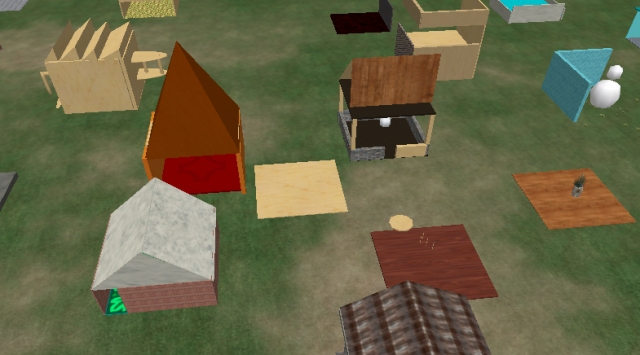 Building in the ‘Burbs
Building in the ‘Burbs
The brief was simple: Make something that looks like something, keep the scale avatar-size and make it as detailed as you have time for.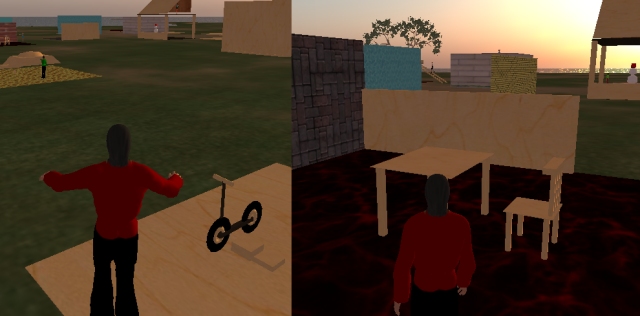
The results were, well, quite wonderful as you can see. Some went the conventional “follow the neighbour” which is quite natural in a free-form activity – creativity coalesces between near neighbours and they are surprised when you point it out to them because they are sure they are being creative and not derivative.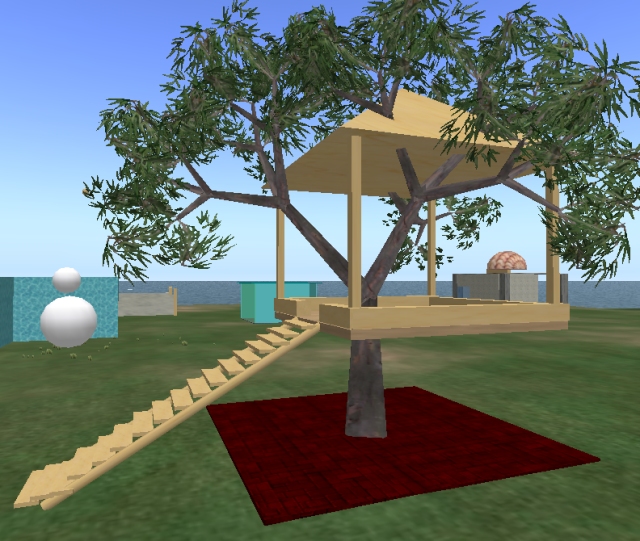
Some lovely ideas expressed, including the practicalities of access, movement and texture. It will be interesting to see how this activity changes with a pair of classes, driven by different teachers next time.
Marking Your Territory
Teaching basic building skills in an OpenSim is fairly straight forward, I have found the kids take to it fairly fast but few think through a quality build first time. Pride in workmanship comes after mastery of the tools I am hoping.
The activity was simple and open-ended – on a designated section of the continent make a slab 10m x 10m x 20cm, nestle it into the ground slightly to become your building “plot”.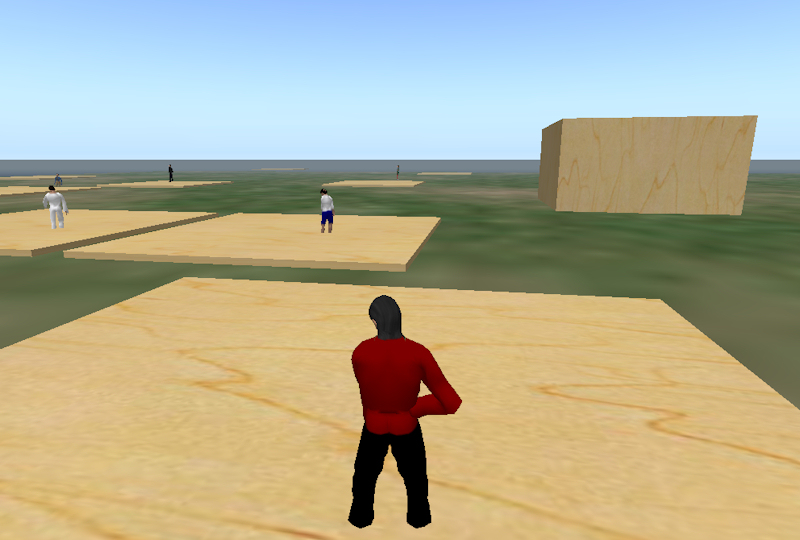
Object creation, scaling and movement skills followed texturing, exploration of other object properties and then a simple brief: make something that looks like something. the only caveat was that it needed to be on their plot, and to scale.
They took to the task with great enthusiasm, exploring the way you construct more complex things from primitives, scaling, rotating, moving with greater and greater precision that comes with experience.
In the end they were inviting their iMates over to have a look, all fairly hoopy. We have, in the next journey into this world, to tie this world activity to the activity happening in MUD and MOO and then look objectively at the whole “amount of activity required to create a unit of believable detail”, but for now, play is a good thing.
Building is the Pits
Trying to scoffold an activity so it fits into a short term means that certain details must be surfaced, processes prepared and scaffolds erected. The “builders academy” is a summary of the tutorial zone on planet Obscura and focusses on skills particular to this building task: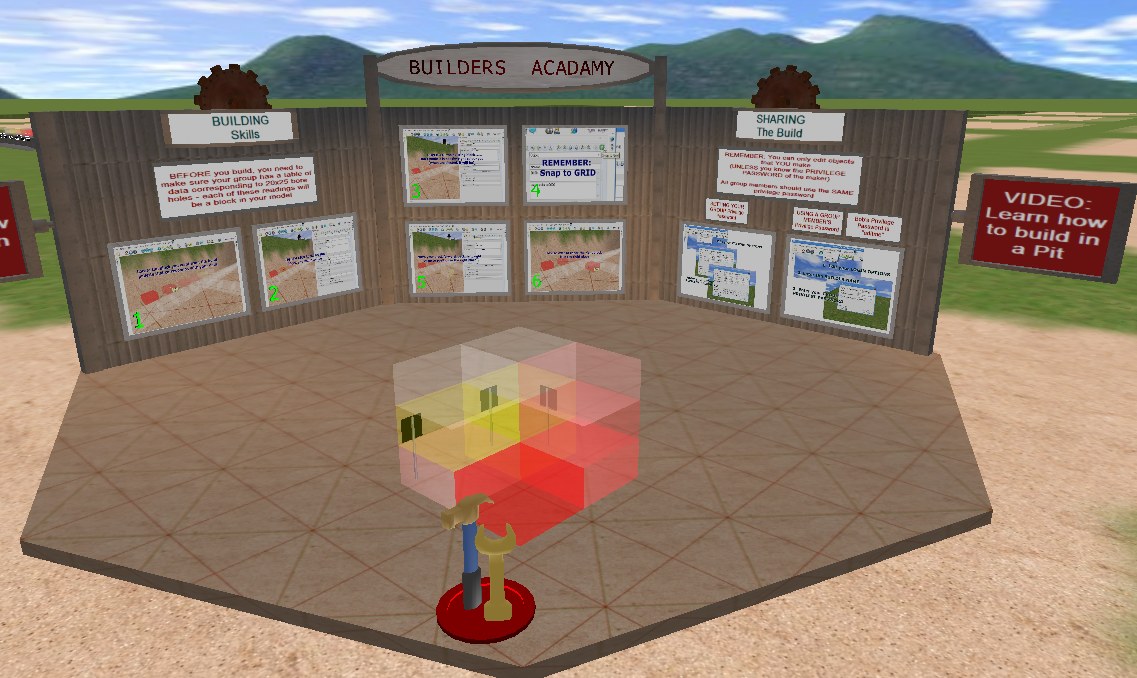
I made a machinema demonstrating techniques, and talking them through more regular tidy building practises, in the hope that if they do not want to read the worded instructions, they might take notice of a human voice modelling what they have to do. I am getting quite good at “multi-modal” explanations, and this is something that Virtual Worlds are particularly good for.
The idea is that cybernauts model, in 3D the readings they have taken in the field. The modelling then creates a 3D representation of the ore body in situ so they can then decide, based on researched costs and benefits, the most appropriate way to extract the ore.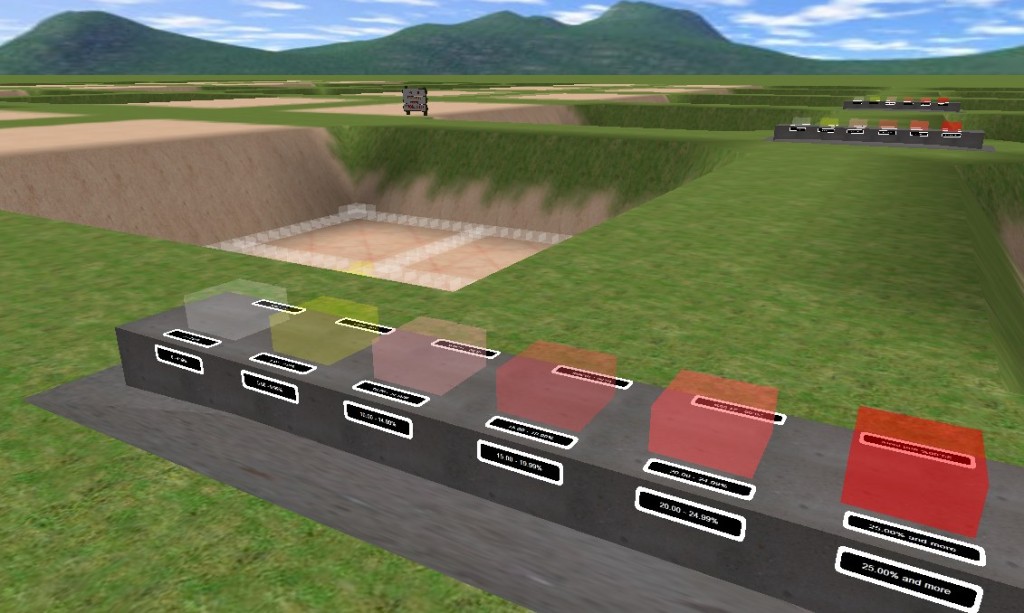 We present them with a “builders pallette” of the objects they need to complete the build – in this instance they are semi-transparent blocks that stack neatly, each representing different mineralisation readings. You can also see in the pit there is a starter grid, centred on the ore body, so they can start building from there without having to worry about aligning, scale and have an idea of extent and scope. Each pit has a “spoils” area to one side, so that later when they are demonstrating the mining technique they have selected, tehr eis somewhere to put their mined waste – again a nice demonstration of the fact that the stuff you dig up and discard has to go somewhere.
We present them with a “builders pallette” of the objects they need to complete the build – in this instance they are semi-transparent blocks that stack neatly, each representing different mineralisation readings. You can also see in the pit there is a starter grid, centred on the ore body, so they can start building from there without having to worry about aligning, scale and have an idea of extent and scope. Each pit has a “spoils” area to one side, so that later when they are demonstrating the mining technique they have selected, tehr eis somewhere to put their mined waste – again a nice demonstration of the fact that the stuff you dig up and discard has to go somewhere.
Most 3D worlds have limits, Activeworlds more than most in some regards, but I learned some valuable lessons in highly intensive, densely packed object arrays by trying to complete the activity we are asking the cybernauts to do, myself.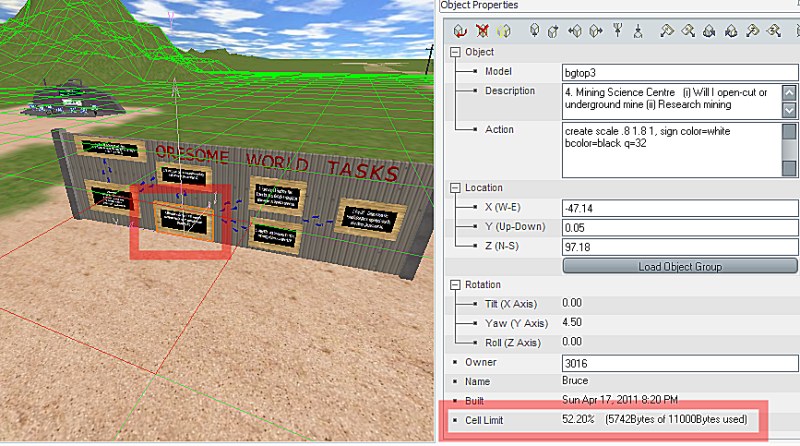
There is this thing called a “cell limit”, it is a PHYSICAL MEMORY limit the world, and I am guessing the rendering engine have whereby the total assets for a grid cell are limited. Each object instance, the NAME of the object, any ACTION scripting applied and any DESCRIPTION add to the storage requirements for that object. In the above screenshot you can see a rather sparse area of the world and a highlighted object alerts us to the fact that we have consumed 52% of the cell limit in that cell (you can see the cell grid in green and the current cell in red). This large cell usage can be explained when you realise there are 135 objects in that cell, most with HUGE names, most with create scripts etc.
This became a critical problem when I was testing the pit construction. Originally I had the blocks with lovely long names, and create scripts and a lovely long description in each – this meant that when I was 2/3 of the way through the building of my model, the WORLD prevented me from building any more in that cell … oops.
The solution was a re-making of ALL blocks (I changed the actual objects to be coloured and transparent in my 3D modelling program rather than do it with scripts in-world), gave them all tiny names (m1 .. m7) and pruned their descriptions down. the upshot of this is that I realise the object catalog that exists currently contains some obscenely wasteful object data – sure the names are descriptive but …
I like it that I am still learning in this project.
Boring
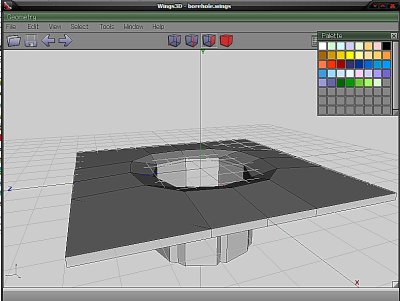 Now one activity cybernauts will have to complete is a collection of bore-samples, detecting mineralization according to depth. The need arose for a scenic object that performs the function of a bore-hole cap.
Now one activity cybernauts will have to complete is a collection of bore-samples, detecting mineralization according to depth. The need arose for a scenic object that performs the function of a bore-hole cap.
I fired up wings, experimented with scale to determine the appropriate size to fit an entire grid point, then sculpted a hole that tapered so it would join to a tube primitive I made earlier.
Testing their placement was fairly straight forward – with the scale correct, they move and position modularly, and it allows me to manage how they will manage taking readings at depth – I thought about sliding core samples with meta information that would slide out of the way to reveal a deeper sample.
If the movement is not “global” then it will appear to move ONLY to the cybernaut that clicks on it, meaning multiple students can work on the same spot at the same time without interfering with each other – an important consideration if there is a class worth in at a time.
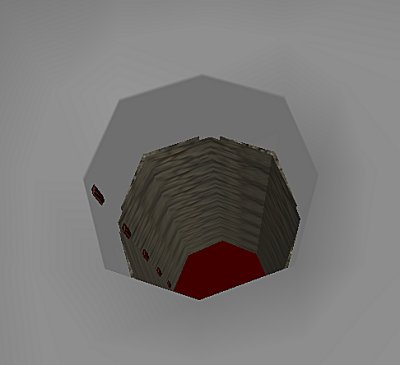 Working out how to texture, colour and so on, then on to layout of the mineral bed; progress being made.
Working out how to texture, colour and so on, then on to layout of the mineral bed; progress being made.
On a purely practical matter, vestiges of the sample are still visible when they are rolled out of the way, so students can still access the data stored in them (you can see the brown fragments still emergent from the shaft wall) .
I think this will work well – what do you think?
Airborne Markers
So I have started work on a new world, full of mining science, called MinexV (or Oresome World … no, don’t ask). In it cybernauts will perform a mineralogical survey and then construct a scale model of the ore body they encounter.
First phase of the survey is a MACRO survey from the air, in a grid they will take gross conductance readings so as to better identify what sectors are worth exploring further.
The aerial survey points need to be indicated somehow, so I thought of meteorological balloons, and made one. Well, yes, in truth it looks more like a party balloon, but the intention was there.
As cybernauts will need to be organised I began to think through ideas for controlling their search pattern, and came up with the idea of a paper plane (inspired by my 356 Origami Project) suspended from the balloon pointing in the direction they should travel.
The idea, in-world is whimsical and should be useful, as I can use different colours to mark out grid locations.
I am still working out drill shaft appearances, and the mechanics of core sampling, but I think that can be done tidily so that multiple people can use the same resources at the same time without interfering with each other.
